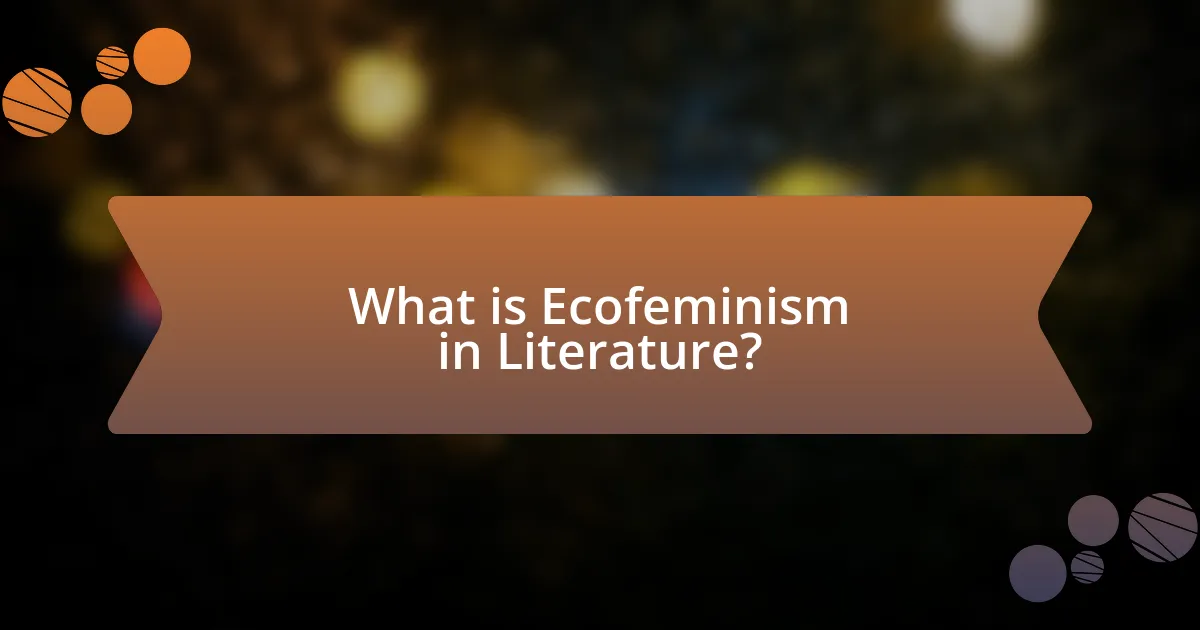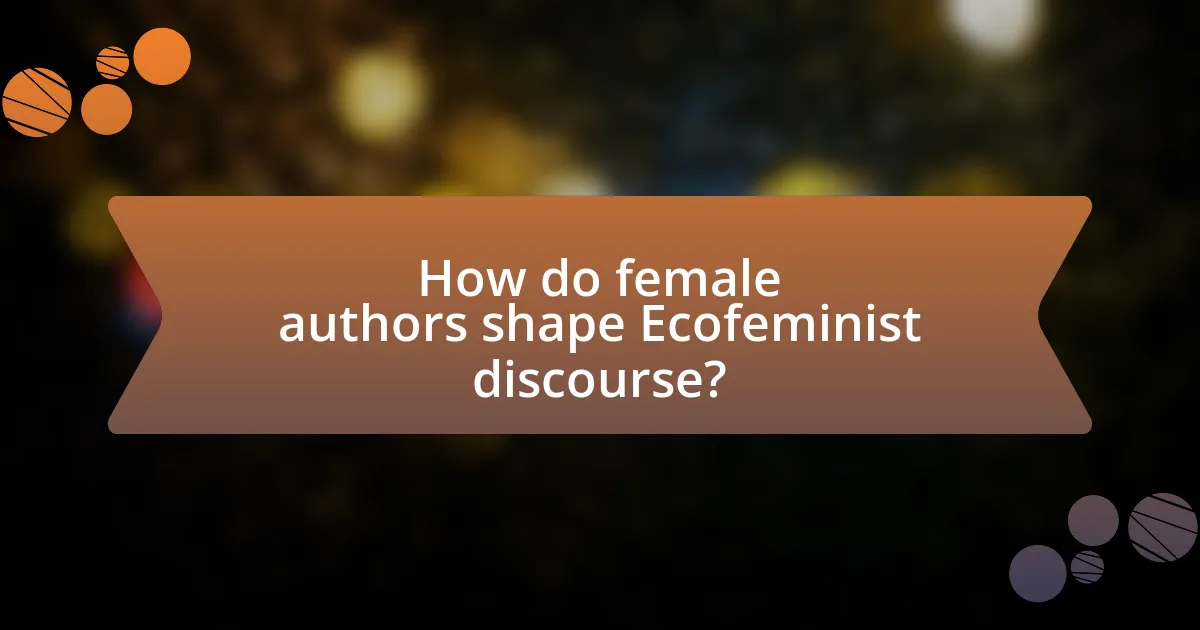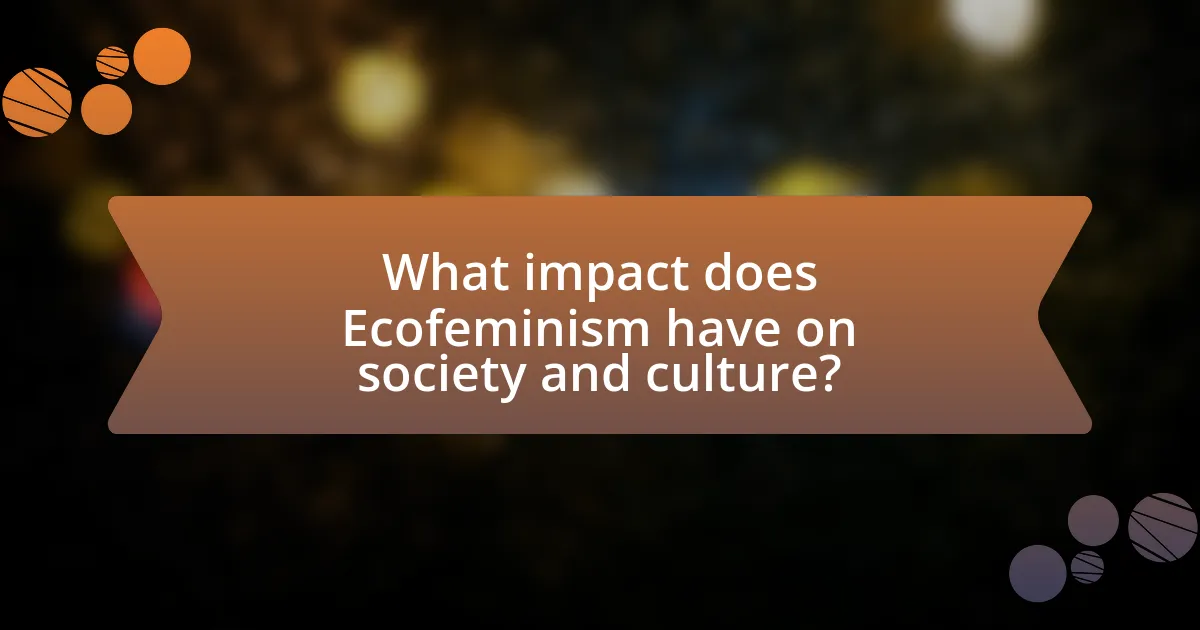Ecofeminism in literature is a critical framework that examines the links between the oppression of women and environmental degradation, emphasizing the interdependence of social justice and ecological sustainability. The article explores how prominent ecofeminist writers, such as Susan Griffin and Vandana Shiva, intertwine narratives addressing gender inequality and environmental issues, thereby enriching the discourse on female contributions to environmental advocacy. It discusses the historical roots of ecofeminism, prevalent themes in ecofeminist literature, and the impact of female voices on environmental narratives, while also addressing the challenges faced by ecofeminist literature in mainstream literary circles. Additionally, it highlights the role of ecofeminist texts in activism and their influence on public perception and environmental policies.

What is Ecofeminism in Literature?
Ecofeminism in literature is a critical framework that explores the connections between the oppression of women and the degradation of the environment. This perspective posits that both women and nature have been historically marginalized and exploited, and it seeks to highlight the interdependence of social justice and ecological sustainability. Prominent ecofeminist writers, such as Susan Griffin and Vandana Shiva, illustrate these themes by intertwining narratives that address both gender inequality and environmental issues, thereby enriching the discourse on how female voices contribute to environmental advocacy.
How does Ecofeminism intersect with environmental discourse?
Ecofeminism intersects with environmental discourse by highlighting the connections between the exploitation of nature and the oppression of women. This perspective argues that both environmental degradation and gender inequality stem from patriarchal structures that prioritize domination over nurturing. For instance, ecofeminist scholars like Vandana Shiva emphasize that the exploitation of natural resources often parallels the marginalization of women, particularly in developing countries, where both are subjected to systemic violence and neglect. This intersection is evident in literature that critiques these dual oppressions, advocating for a holistic approach to environmental issues that incorporates feminist perspectives.
What are the historical roots of Ecofeminism in literature?
The historical roots of Ecofeminism in literature can be traced back to the intersection of feminist theory and environmentalism, emerging prominently in the late 20th century. Key literary figures such as Rachel Carson, whose work “Silent Spring” (1962) highlighted the dangers of pesticides, laid foundational ideas that connected the exploitation of nature with patriarchal structures. Additionally, authors like Susan Griffin and Vandana Shiva further developed Ecofeminist thought by critiquing the dualism of nature versus culture and advocating for a holistic understanding of women’s roles in environmental stewardship. These literary contributions established a framework that emphasizes the interconnectedness of gender, ecology, and social justice, influencing subsequent generations of writers and activists in the Ecofeminist movement.
How do female voices contribute to environmental narratives?
Female voices contribute to environmental narratives by offering unique perspectives that intertwine ecological concerns with social justice issues. This contribution is evident in ecofeminist literature, where female authors often highlight the interconnectedness of gender, race, and environmental degradation. For instance, writers like Rachel Carson and Vandana Shiva emphasize the role of women in environmental stewardship and the impact of environmental policies on marginalized communities. Their narratives challenge traditional patriarchal views and advocate for sustainable practices that consider both ecological health and social equity. This approach not only enriches the discourse but also mobilizes diverse audiences to engage with environmental issues more holistically.
Why is Ecofeminism important in contemporary literature?
Ecofeminism is important in contemporary literature because it intertwines ecological concerns with feminist perspectives, highlighting the interconnectedness of gender and environmental issues. This literary movement emphasizes the voices of women, who often experience both social and environmental injustices, thereby enriching the discourse on sustainability and social equity. For instance, authors like Vandana Shiva and Arundhati Roy illustrate how patriarchal structures contribute to ecological degradation, making their works pivotal in understanding the complexities of environmental crises. By integrating these themes, ecofeminist literature fosters a more inclusive dialogue about ecological responsibility and social justice, ultimately influencing contemporary environmental activism and policy discussions.
What themes are prevalent in Ecofeminist literature?
Prevalent themes in Ecofeminist literature include the interconnectedness of nature and women, the critique of patriarchy, and the advocacy for environmental justice. These themes highlight how the exploitation of the environment parallels the oppression of women, emphasizing a holistic approach to both ecological and gender issues. For instance, authors like Vandana Shiva argue that the degradation of the environment disproportionately affects women, particularly in developing countries, thereby reinforcing the need for a feminist perspective in environmental discourse. Additionally, Ecofeminist literature often explores the spiritual and ethical dimensions of nature, advocating for a more compassionate relationship between humans and the natural world.
How does Ecofeminism challenge traditional literary perspectives?
Ecofeminism challenges traditional literary perspectives by integrating ecological concerns with feminist critiques, thereby questioning the patriarchal structures that dominate both nature and women’s experiences. This approach highlights the interconnectedness of gender oppression and environmental degradation, arguing that literature often reflects and perpetuates these hierarchies. For instance, ecofeminist writers like Susan Griffin and Vandana Shiva emphasize the need to recognize women’s roles in environmental stewardship, contrasting with traditional narratives that marginalize female voices. By doing so, ecofeminism not only redefines literary themes but also advocates for a more inclusive understanding of ecological issues, ultimately reshaping the discourse around both gender and the environment.

How do female authors shape Ecofeminist discourse?
Female authors shape Ecofeminist discourse by integrating feminist perspectives with ecological concerns, thereby highlighting the interconnectedness of gender and environmental issues. Through their narratives, these authors challenge patriarchal structures that exploit both women and nature, as seen in works like “The Woman Who Walked into Doors” by Roddy Doyle, which illustrates the impact of domestic violence on women’s relationship with their environment. Additionally, authors such as Vandana Shiva emphasize the importance of women’s roles in sustainable practices and biodiversity, arguing that women’s knowledge is crucial for ecological preservation. This dual focus on gender equality and environmental justice enriches Ecofeminist discourse, making it more inclusive and actionable.
What are some key works of Ecofeminist literature?
Key works of Ecofeminist literature include “The Death of Nature” by Carolyn Merchant, which critiques the historical connection between the exploitation of nature and the oppression of women. Another significant work is “Ecofeminism” by Greta Gaard and Lori Gruen, which explores the intersections of ecological and feminist thought. Additionally, “Woman on the Edge of Time” by Marge Piercy presents a vision of a future where gender and environmental justice coexist. These texts collectively highlight the relationship between ecological issues and feminist perspectives, reinforcing the validity of ecofeminist discourse.
Who are the prominent female authors in this genre?
Prominent female authors in the ecofeminism genre include Rachel Carson, whose groundbreaking work “Silent Spring” (1962) highlighted the dangers of pesticides and their impact on the environment, and Vandana Shiva, known for her advocacy on biodiversity and sustainable agriculture. Additionally, authors like Arundhati Roy, with her novel “The Ministry of Utmost Happiness,” intertwine ecological themes with social justice, while Alice Walker’s “The Color Purple” explores the connections between gender, race, and environmental issues. These authors significantly contribute to the discourse on the intersection of feminism and environmentalism, shaping the narrative around ecofeminism.
What literary techniques do these authors employ?
Authors in ecofeminist literature employ techniques such as symbolism, imagery, and narrative perspective to convey their messages. Symbolism is used to represent the interconnectedness of women and nature, often depicting natural elements as reflections of female experiences. Imagery enhances the emotional impact of environmental themes, creating vivid pictures that evoke a sense of urgency regarding ecological issues. Additionally, a unique narrative perspective, often from a female point of view, challenges traditional patriarchal narratives and emphasizes the importance of women’s voices in environmental discourse. These techniques collectively reinforce the core principles of ecofeminism, highlighting the relationship between gender and ecological concerns.
How do these authors address environmental issues?
These authors address environmental issues by intertwining ecological concerns with feminist perspectives, highlighting the interconnectedness of gender and environmental degradation. They illustrate how patriarchal structures contribute to environmental exploitation, using narratives that emphasize the voices and experiences of women in relation to nature. For instance, authors like Rachel Carson in “Silent Spring” expose the detrimental effects of pesticides on both the environment and women’s health, while contemporary ecofeminist writers advocate for sustainable practices that honor both female empowerment and ecological balance. This approach not only critiques existing environmental policies but also proposes alternative frameworks that prioritize both ecological integrity and social justice.
What specific environmental themes are explored in their works?
The specific environmental themes explored in ecofeminist literature include the interconnectedness of nature and gender, the critique of patriarchal structures that exploit both women and the environment, and the advocacy for sustainable practices that honor ecological balance. These themes highlight how the oppression of women parallels environmental degradation, emphasizing the need for a holistic approach to both social justice and ecological preservation. For instance, authors like Vandana Shiva argue that the exploitation of natural resources often reflects the exploitation of marginalized communities, reinforcing the idea that environmental issues cannot be separated from social issues.
How do personal narratives enhance the Ecofeminist message?
Personal narratives enhance the Ecofeminist message by providing individual experiences that illustrate the interconnectedness of gender and environmental issues. These narratives often highlight the personal impact of ecological degradation on women’s lives, thereby making abstract environmental concepts more relatable and urgent. For instance, women in various cultures share stories of their struggles against environmental exploitation, which underscores the systemic nature of both patriarchy and ecological harm. This storytelling approach fosters empathy and understanding, encouraging readers to recognize the importance of addressing both gender inequality and environmental sustainability as intertwined issues.

What impact does Ecofeminism have on society and culture?
Ecofeminism significantly impacts society and culture by intertwining ecological concerns with feminist perspectives, promoting a holistic understanding of environmental issues. This movement challenges traditional gender roles and advocates for the rights of both women and nature, emphasizing the interconnectedness of social justice and environmental sustainability. For instance, ecofeminist literature often highlights the exploitation of women and the environment, as seen in works by authors like Vandana Shiva, who argues that the degradation of nature parallels the oppression of women. This perspective fosters greater awareness and activism around issues such as climate change, biodiversity loss, and social inequality, ultimately influencing policies and cultural narratives that prioritize ecological and gender justice.
How does Ecofeminism influence public perception of environmental issues?
Ecofeminism influences public perception of environmental issues by linking the exploitation of nature to the oppression of women, thereby fostering a holistic understanding of ecological and social justice. This perspective encourages individuals to view environmental degradation as interconnected with gender inequality, promoting a more inclusive dialogue around sustainability. Research indicates that ecofeminist literature often highlights the voices of marginalized women, which can shift societal attitudes towards environmental activism and policy-making, as seen in works by authors like Vandana Shiva and Carolyn Merchant. Their contributions emphasize the need for a gendered approach to environmental issues, which can lead to greater public awareness and engagement in ecological conservation efforts.
What role do Ecofeminist texts play in activism?
Ecofeminist texts play a crucial role in activism by intertwining environmental issues with feminist perspectives, thereby highlighting the interconnectedness of gender oppression and ecological degradation. These texts serve as a platform for marginalized voices, advocating for social justice and environmental sustainability. For instance, authors like Vandana Shiva and Arundhati Roy emphasize the exploitation of both women and nature, urging activists to address these dual injustices. By framing environmental activism through a feminist lens, ecofeminist literature mobilizes communities, inspires grassroots movements, and fosters a holistic understanding of ecological crises, ultimately driving systemic change.
How can literature inspire change in environmental policies?
Literature can inspire change in environmental policies by raising awareness and shaping public discourse around ecological issues. Through narratives that highlight the interconnectedness of gender and environmental degradation, literature can mobilize readers to advocate for policy reforms. For instance, works by authors like Rachel Carson, whose book “Silent Spring” played a pivotal role in the environmental movement, illustrate how compelling storytelling can influence public perception and lead to legislative action, such as the establishment of the Environmental Protection Agency in the United States. Additionally, ecofeminist literature often emphasizes the importance of diverse voices in environmental advocacy, thereby encouraging inclusive policy-making that considers the experiences of marginalized communities.
What are the challenges faced by Ecofeminist literature?
Ecofeminist literature faces several challenges, including marginalization within both feminist and environmental discourses. This literature often struggles to gain recognition due to its intersectional approach, which combines ecological concerns with feminist perspectives, leading to resistance from traditional literary critics who may prioritize one over the other. Additionally, ecofeminist texts frequently confront the challenge of being perceived as overly idealistic or lacking in practical solutions, which can undermine their impact in addressing real-world environmental issues. Furthermore, the diverse cultural contexts of ecofeminism can complicate its universal applicability, making it difficult to establish a cohesive narrative that resonates across different societies. These challenges highlight the ongoing struggle for ecofeminist literature to assert its relevance and influence in broader discussions about gender and environmentalism.
How is Ecofeminism received in mainstream literary circles?
Ecofeminism is increasingly recognized and discussed in mainstream literary circles, often celebrated for its intersectional approach that combines ecological concerns with feminist perspectives. This recognition is evident in the growing number of literary works and critical essays that explore themes of environmental justice through a feminist lens, such as the writings of authors like Vandana Shiva and Arundhati Roy. Additionally, academic journals and literary reviews have begun to feature ecofeminist critiques, indicating a shift towards integrating these ideas into broader literary discourse. The increasing visibility of ecofeminism in literature reflects a broader societal acknowledgment of the interconnectedness of gender and environmental issues, as evidenced by the inclusion of ecofeminist themes in popular literature and discussions at literary festivals.
What barriers exist for female authors in this field?
Barriers for female authors in ecofeminism include gender bias, limited access to publishing opportunities, and a lack of representation in literary criticism. Gender bias manifests in the form of stereotypes that undermine women’s authority in environmental discourse, often leading to their work being undervalued. Limited access to publishing opportunities is evidenced by statistics showing that women are less likely to be published in prestigious literary journals compared to their male counterparts. Additionally, a lack of representation in literary criticism means that female authors’ contributions to ecofeminism may not receive the recognition they deserve, further perpetuating the cycle of marginalization.
What practical steps can readers take to engage with Ecofeminism in literature?
Readers can engage with Ecofeminism in literature by actively seeking out and reading works by Ecofeminist authors, such as Vandana Shiva and Rachel Carson, who explore the intersection of gender and environmental issues. Additionally, participating in book clubs or discussion groups focused on Ecofeminist literature can enhance understanding and foster dialogue about the themes presented. Engaging with academic articles and critiques on Ecofeminism will provide deeper insights into the theoretical frameworks that underpin these literary works. Furthermore, readers can support independent bookstores and publishers that prioritize Ecofeminist literature, thereby promoting diverse voices in the literary landscape.
How can readers support Ecofeminist authors and their works?
Readers can support Ecofeminist authors and their works by purchasing their books, promoting their writings on social media, and participating in discussions about their themes. By buying books, readers directly contribute to the authors’ financial success, which is crucial for sustaining their work. Sharing insights and quotes from Ecofeminist literature on platforms like Twitter and Instagram raises awareness and encourages others to explore these authors. Engaging in book clubs or online forums focused on Ecofeminism fosters community dialogue and amplifies the authors’ messages, further solidifying their impact in environmental discourse.
What resources are available for further exploration of Ecofeminism in literature?
Key resources for further exploration of Ecofeminism in literature include academic journals, books, and online databases. Notable academic journals such as “Environmental Humanities” and “Feminist Studies” publish articles that analyze the intersection of gender and environmental issues. Essential books include “Ecofeminism” by Greta Gaard, which provides foundational insights, and “The Ecological Feminist” by Karen J. Warren, which explores philosophical perspectives. Online databases like JSTOR and Project MUSE offer access to a wide range of scholarly articles and papers on Ecofeminism, facilitating deeper research into how female voices influence environmental discourse.
